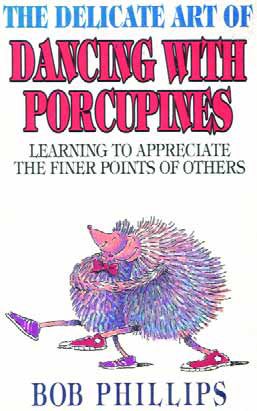Of Porcupines and Personalities

The Delicate Art of Dancing with Porcupines by Bob Phillips (Regal Books, 1989) may have one of the most unusual titles I’ve ever seen, but fortunately the quirky name didn’t stop from picking it up several years ago. At this point, I’ve read it multiple times and have taken to presenting it quite often as a gift to friends and associates.
I like it so well myself because the text applies in practical and profound ways to my work as a watershape designer. I share it with others because it has had something to say about every aspect of my life and can do the same for them, too.
A widely published marriage and family counselor, Phillips is best known for this small book (just 160 pages) in which he examines in wonderfully clear and concise detail what he calls “social style.” The idea is that people generally fall into categories having to do with how they communicate with and relate to other people – and that they will exhibit more or less predictable responses based upon the extent to which they fit into one category or another.
I hesitated to buy into anything he was saying at first, because I have a basic inclination to avoid viewing other people through stereotypes. And I’ve always chafed at the notion that I myself could be pigeonholed as one “type” of person or another.
I overcame those reservations as I began considering his approach in light of my own experiences in dealing with other people, whether at home or in the workplace. I also saw that it wasn’t about stereotypes and that, in fact, he allows for all of the diverse personalities we encounter while helping us find effective ways of communicating with others by understanding their styles and personal preferences.
Basically, Phillips defines two sliding scales of personality types, classifying us as either relationship- or task-oriented and as tellers or askers. On a graph, his approach sets us on four basic quadrants, and each of us can be plugged into the graph somewhere depending upon how we combine the four characteristics.
To clarify how it all works, he describes a variety of personal characteristics that are typical of people in each category and how the extent to which someone fits those criteria (and to what degree) determines their social style. He explores how various personality types will tend to interact with others in a variety of situations – in the workplace, in romantic or spousal relationships, in raising children or in making major decisions.
I now consider Phillips’ categories as I interact with my watershape clients (who are certainly in the process of making major purchasing decisions), and I’ve found the insights to be useful in the detective work I do in determining what my clients really want and how best to connect with them. It all makes perfect sense to me: The more I understand my clients, the better able I will be to do my job and make them happy.
I’ve read a number of other books that fall into this basic category of examining personality types, but by and large I’ve found them to be difficult to grasp and apply. For his part, Phillips does a wonderful job of explaining his ideas in simple, straightforward ways.
Because watershaping is a business that requires close interaction with and a good understanding of clients (not to mention colleagues and other members of a project team), I’ve used what I’ve learned from Phillips’ book over and over again in a huge range of situations. I have the hunch that if you read this book with an open mind and consider how it stacks up against what you know about yourself and others, you may find yourself just as compelled as I’ve been share it with family and friends.
Mike Farley is a landscape designer with more than 20 years of experience and is currently a designer/project manager for Claffey Pools in Southlake, Texas. A graduate of Genesis 3’s Level I Design School, he holds a degree in landscape architecture from Texas Tech University and has worked as a watershaper in both California and Texas.










